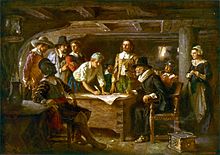
John Carver was one of the Pilgrims who made the Mayflower voyage in 1620 which resulted in the creation of Plymouth Colony in America. He is credited with writing the Mayflower Compact and was its first signer, and was also the first governor of Plymouth Colony.

Francis Cooke was a Leiden Separatist, who went to America in 1620 on the Pilgrim ship Mayflower, which arrived at Plymouth, Massachusetts. He was a founding member of the Massachusetts Bay Colony, and a signer of the Mayflower Compact.

Degory Priest was a member of the Leiden contingent on the historic 1620 voyage of the ship Mayflower. He was a hat maker from London who married Sarah, sister of Pilgrim Isaac Allerton in Leiden. He was a signatory to the Mayflower Compact in November 1620 and died less than two months later.

Thomas Rogers was a Leiden Separatist who traveled in 1620 with his eldest son Joseph as passengers on the historic voyage of the Pilgrim ship Mayflower.

Christopher Martin and his family embarked on the historic 1620 voyage of the Pilgrim ship Mayflower on its journey to the New World. He was initially the governor of passengers on the ship Speedwell until that ship was found to be unseaworthy, and later on the Mayflower, until replaced by John Carver. He was a signatory to the Mayflower Compact. He and his family all perished in the first winter at Plymouth Colony.

Thomas Tinker and his family, comprising his wife and son, came in 1620 as English Separatists from Holland on the historic voyage of the Pilgrim Ship Mayflower. He was a signatory to the Mayflower Compact but he and his family all perished in the winter of 1620/1621, described by Bradford as having died in "the first sickness."

Richard Warren was one of the passengers on the Pilgrim ship Mayflower and a signer of the Mayflower Compact.

George Soule was a colonist who was one of the indentured servants on the Mayflower and helped establish Plymouth Colony in 1620. He was one of the signers of the Mayflower Compact.

Humility Cooper, of Leiden, Holland, traveled in 1620 on the voyage of the ship Mayflower as a one-year-old female child in the company of the Edward Tilley family. Although Edward Tilley and his wife died the first winter in the New World, Humility survived to live her young life in Plymouth Colony, returning to England possibly in her teen years. Her fate in England is unknown.

Samuel Fuller was a passenger on the historic 1620 voyage of the Pilgrim ship Mayflower and became a respected church deacon and the physician for Plymouth Colony.

Henry Samson In 1620 Henry Samson travelled as a member of the Edward Tilley family on the historic voyage of the Pilgrim ship Mayflower. The Tilleys died in the first winter but Henry Samson survived to live a long, fulfilling life in Plymouth Colony.

Edward Tilley traveled in 1620 on the historic voyage of the ship Mayflower as a Separatist member of the Leiden, Holland contingent. He was a signatory to the Mayflower Compact, and died with his wife in the first Pilgrim winter in the New World.

William White was a passenger on the Mayflower. Accompanied by his wife Susanna, son Resolved and two servants, and joined by a son, Peregrine, on the way, he traveled in 1620 on the historic voyage. He was a signatory to the Mayflower Compact and perished early in the history of Plymouth Colony.

Resolved White was a passenger on the Pilgrim ship Mayflower. In 1620, he accompanied his parents, Pilgrims William and Susanna White, on the journey. He married Judith Vassall, daughter of William Vassall, a founder of the Massachusetts Bay Colony. Later in life White became a notable person of Plymouth Colony.

William Mullins and his family traveled as passengers on the historic 1620 voyage to America on the Pilgrim ship Mayflower. He was a signatory to the Mayflower Compact. Mullins perished in the pilgrims' first winter in the New World, with his wife and son dying soon after.
William Bassett was an English artisan, a migrant to North America.
John Winslow (1597–1674) was one of several Winslow brothers who came to the Plymouth Colony in its earliest years. His brothers Edward and Gilbert were passengers on the Mayflower in 1620. John Winslow was a passenger on the Fortune in 1621, and two other brothers, Kenelm and Josiah, also settled in New England, arriving before 1632. The Winslow family were involved in all aspects of the Plymouth Colony, producing in the 17th century several governors and making their mark in New England history in both government and business.
In 1623 the ships Anne and Little James were the third and fourth ships financed by the London-based Merchant Adventurers to come out together in support of Plymouth Colony, as were Mayflower in 1620 and Fortune in 1621. Anne carried mostly passengers, and the much smaller Little James carried primarily cargo, albeit with a few passengers. After a stormy three-month voyage from London, Anne arrived at New Plymouth in early July 1623, with Little James a week or so later.
Also see: The ships Anne and Little James




